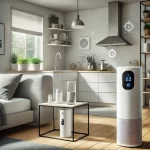Introduction
Sustainability has become a core aspect of home design, with many homeowners looking for eco-friendly upgrades that reduce environmental impact while promoting a healthier living space. Whether you’re renovating or just making small improvements, there are numerous ways to make your home more environmentally friendly and healthier for your family. In this blog post, we’ll explore green home upgrades that enhance both health and quality of life.

1. Natural Building Materials
Eco-Friendly Advantage:
Natural building materials like bamboo, reclaimed wood, and stone are sustainable alternatives to conventional building materials. These materials have a lower carbon footprint and fewer harmful chemicals compared to synthetic options.
Health Benefits:
Natural materials reduce the presence of toxic chemicals in your home, improving indoor air quality. They also prevent off-gassing, a process where harmful chemicals are released into the air, contributing to healthier living conditions for you and your family.
How to Use:
Use bamboo for flooring, reclaimed wood for furniture or wall accents, and natural stone for countertops and backsplashes.
2. Eco-Friendly Paints
Eco-Friendly Advantage:
Conventional paints often contain volatile organic compounds (VOCs), which contribute to indoor air pollution. Eco-friendly, non-toxic paints are free from VOCs and other harmful chemicals, reducing environmental impact and improving air quality.
Health Benefits:
Using VOC-free paints significantly reduces exposure to toxic fumes that can cause respiratory issues, headaches, and other health problems. This leads to a cleaner and healthier indoor environment.
How to Use:
When painting your home, opt for eco-friendly paints and finishes that are labeled as low or no-VOC. These are available in a variety of colors and finishes to suit your design preferences.
3. Energy-Efficient Appliances
Eco-Friendly Advantage:
Energy-efficient appliances, such as those with the ENERGY STAR rating, use significantly less energy than standard models. This reduces your home’s overall energy consumption, helping to lower greenhouse gas emissions.
Health Benefits:
Energy-efficient appliances often come with additional features that improve indoor comfort, such as better temperature control and reduced noise levels, creating a more comfortable and healthy living space.
How to Use:
Upgrade your home with energy-efficient refrigerators, washing machines, dishwashers, and HVAC systems to reduce energy consumption and improve your household’s overall efficiency.
4. Sustainable Insulation
Eco-Friendly Advantage:
Traditional insulation materials can contain harmful chemicals and contribute to energy waste. Sustainable insulation materials, such as cellulose, wool, or recycled cotton, are non-toxic and provide excellent thermal performance, reducing your home’s energy needs.
Health Benefits:
Sustainable insulation improves indoor air quality by preventing the release of harmful chemicals into the air. Additionally, better insulation helps maintain a consistent indoor temperature, improving comfort and reducing the risk of mold growth.
How to Use:
Replace old or inefficient insulation with eco-friendly options during your next renovation. This will lower energy costs and create a healthier indoor environment.
5. Water-Efficient Fixtures
Eco-Friendly Advantage:
Installing water-efficient fixtures, such as low-flow toilets, faucets, and showerheads, helps reduce water waste and lowers utility bills. These fixtures use advanced technology to maintain strong water pressure while conserving water.
Health Benefits:
Water-efficient fixtures help prevent water contamination and reduce the strain on local water supplies, contributing to a cleaner and healthier water system.
How to Use:
Upgrade bathrooms and kitchens with water-efficient fixtures to conserve water without sacrificing performance.
Sustainable Home Upgrades and Their Benefits
| Upgrade Project | Eco-Friendly Advantage | Health Benefits |
|---|---|---|
| Natural Building Materials | Reduces harmful chemical emissions, lowers carbon footprint | Improves indoor air quality, protects family health |
| Eco-Friendly Paints | VOC-free, reduces indoor air pollution | Provides a healthier indoor environment |
| Energy-Efficient Appliances | Lowers energy consumption, reduces carbon emissions | Creates a more comfortable and energy-efficient home |
| Sustainable Insulation | Non-toxic, reduces energy waste | Enhances air quality, maintains consistent temperature |
| Water-Efficient Fixtures | Conserves water, lowers utility bills | Reduces water contamination, promotes water sustainability |
Conclusion
Sustainable home improvement not only benefits the environment but also enhances your home’s health and comfort. By choosing natural building materials, eco-friendly paints, energy-efficient appliances, sustainable insulation, and water-efficient fixtures, you can create a home that’s both eco-friendly and healthier for your family. These small but impactful upgrades can make a big difference in your overall quality of life.

